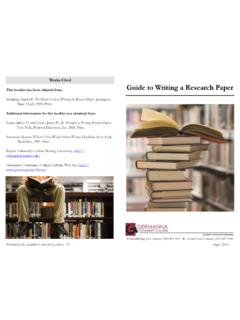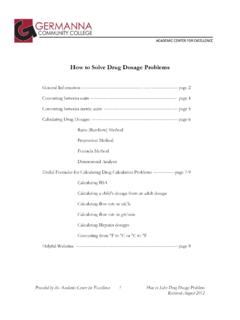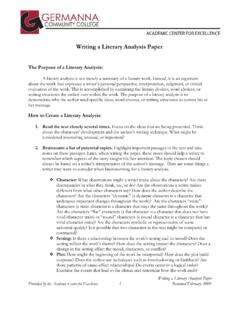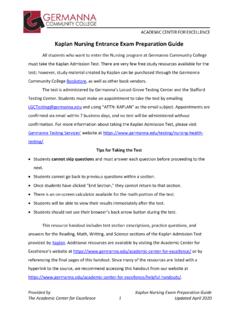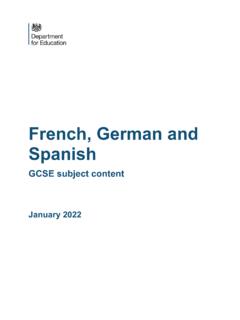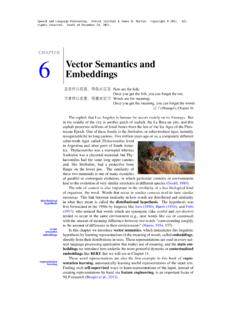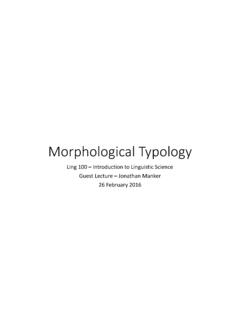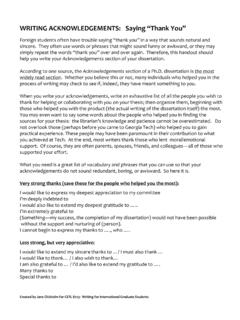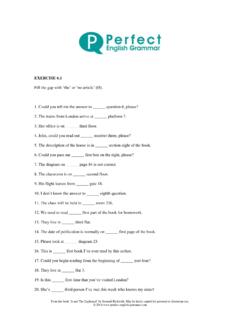Transcription of English as a Second Language (ESL): Use of Articles
1 Provided by the Academic Center for Excellence 1 ESL: Use of Articles Summer 2014 English as a Second Language (ESL): Use of Articles One of the most confusing parts of English grammar for many non-native speakers is the use of Articles . In English , Articles are used to modify nouns in certain situations; they are not used before every noun . There are two types of Articles : indefinite (a, an) and definite (the). Indefinite Articles are used when the speaker or writer is talking about a non-specific member of a group, while a definite article is used for a specific member(s) of a group. Note. The following rules for choosing Articles apply to both speaking and writing, so any mention of a speaker could also apply to a writer.
2 Indefinite Articles (A/An) Indefinite Articles are used when a speaker is talking about a non-specific noun that could be any member of a group. An indefinite article can only modify a singular count noun . A count noun is any noun that can be counted, such as the noun table (How many tables are there?) or baby (How many babies are there?). Noncount nouns are nouns that cannot be counted, such as rice or courage. (How many rices/courages are there? are nonsensical questions.) A: Use a to modify a non-specific, singular count noun that begins with a consonant sound. In addition to consonants, this includes words that begin with the following sounds: yoo (IPA: [ju:]) as in the words user or European and wo (IPA: [w ]) as in the word one.
3 A couple of examples are given below: o A raindrop fell from the sky. (One raindrop fell, and whichever one it was out of the whole group of raindrops does not matter.) o That novel has a one-dimensional heroine. ( One-dimensional begins with a wo sound [w ], and the noun being modified is singular and could be any member of the group of heroines.) Provided by the Academic Center for Excellence 2 ESL: Use of Articles Summer 2014 o A user can access his account with the password. ( User begins with the yoo sound [ju:], and the noun being modified is singular and could be any member of the group of users.)
4 A can also be used to make generalizations, as in the following examples: o A pen is a writing utensil. (This is a general statement about any and all pens.) o A dog is a common household pet. (This is a general statement about any and all dogs.) An: Use an to modify a non-specific, singular count noun that begins with a vowel sound. This includes vowels as well as words that begin with a silent h as in herb or honor. Below are a couple of examples: o An elephant escaped from the zoo. ( Elephant is a singular, non-specific count noun that begins with a vowel.) o He planted an herb garden in his yard.
5 ( Herb begins with a silent h and is a singular, non-specific count noun .) Definite Articles (The) A definite article is used when a speaker is talking about a specific member of a group. The noun being modified can be either singular or plural, as well as count or noncount. Unlike indefinite Articles , a definite article is used only when the noun is known to both the speaker and the listener. Below are a few examples: o The dishes need to be washed. (The speaker is talking about a particular group of dishes that is a specific part of the group of all dishes.) o Her piano is in the living room. (The speaker is talking about a particular living room which is a specific member of the group of all living rooms.)
6 O The happiness of others is important to him. (The speaker is talking about a specific happiness, not happiness as a general idea, so a definite article is required.) Provided by the Academic Center for Excellence 3 ESL: Use of Articles Summer 2014 Note. If a/an has been used with a noun when it is first mentioned, the article changes to the when the same noun is mentioned later. o The local newspaper printed an article about pet health yesterday. The article discussed how to protect dogs from ticks. No article Certain nouns require neither an indefinite nor definite article before them. Here are a few of the most common guidelines: When making generalizations with plural nouns, no article is used.
7 O Peaches grow on trees. (This is a general statement about peaches, which is a plural count noun .) No article is needed before abstract nouns. o Education is important. (The speaker is talking about the abstract concept of education which is something that can only be thought of and not physically sensed.) Most proper nouns do not need an article . o Brazil is the largest country in South America. (Country and continent names are proper nouns that do not need an article before them.) o She can speak spanish and French. ( Language names are also proper nouns that do not need an article .) Exceptions.
8 Although most proper nouns do not need an article , there are several exceptions to this rule. Some examples of the most common types of exceptions are given below: o Dutch is the official Language of the Netherlands. (Use a definite article before the name of a country or geographical location if the name suggests that it contains separate regions or areas.) o The climate is warmer in the South. (Use a definite article before the name of a specific region or area.) Provided by the Academic Center for Excellence 4 ESL: Use of Articles Summer 2014 o The Pacific Ocean is the largest ocean in the world.
9 (A definite article is needed before the names of oceans, as well as deserts and rivers.) o The University of Pennsylvania is a strong research institution. (A definite article is used before college and university names when university or college is the first word in the name.) o The Natural History Museum is located in Washington, (Use a definite article before the names of museums and libraries.) Flowchart The flowchart below, featured in the worksheet Articles ! by the Connors Writing Center at the University of New Hampshire, shows the basic process of choosing an article : Start with a noun Yes No Use THE Ex: Please put the sugar on the table.
10 Yes Use NO article ( ) No Ex: George Washington Sprint Wireless Yes Singular Use A or AN Ex: Can you buy me a cup of coffee? No Use NO article Plural Ex: Please buy sugar at the store.

